China’s economic slowdown and spillovers to Africa
Bottom lines up front
- On balance, the best long-term outcome for Africa is likely one in which China accepts the cost of reform.
- Demand for minerals will grow about 5 percent per year under all scenarios but only a reform scenario sees Chinese demand for African manufactures grow.
- Chinese exports of commodities and manufactures to Africa are set to grow only 4 to 6 percent per annum in all scenarios, a marked decline from annual growth rates above 10 percent between 2020 and 2024.
Executive summary
China’s economic rise and its integration with Africa have catalyzed new infrastructure and industries across the continent. But this also now exposes African countries to negative ripple effects from changes in China’s domestic economy. As China’s investment- and manufacturing-centric economic model loses steam, African officials and policymakers will need to plan for growth and economic transformation, with an understanding that their largest trade and investment partner might look very different than it has over the past decade.
This report investigates how different projections of China’s economic growth and structure over the next five years (through 2030) will affect trade and financial engagement with the African continent, and what these outcomes will mean for decision-makers. It deploys a novel framework to estimate how economic flows between China and Africa shift under different growth scenarios. To account for Africa’s diverse economies—spanning some of the world’s least developed countries as well as high-income financial centers—this analysis extends to country groups.
No growth scenario in China will benefit all of Africa’s nations equally. But on balance, the best long-term outcome for Africa is likely one in which China accepts the cost of reform to implement slower, but more stable, growth. While countries could previously envision the net benefits of close trading relationships with China in 2030, trade now presents both opportunity and threat: opportunity in the form of cheap imports, but complication in the form of persistent trade imbalances and overcapacity in manufacturing. Under any growth scenario, finance from China’s banks and investors will continue to decline—whether sharply or gradually—as China’s domestic financial system evolves.
Chapter 1 surveys economic conditions in Africa as of 2025, as well as how commodity markets and external imbalances make many African countries vulnerable to shifts in the global growth environment and in their economic relationships with China. Even countries with limited direct exposure to China are likely to feel the impact of a slowdown via regional economic linkages and the effect of China’s exports and imports on global prices.
Chapter 2 provides an overview of trade and financial flows between China and Africa. While the importance of individual flows varies, a few channels account for the majority of economic value: goods trade, commercial and development finance, and foreign direct investment (FDI). Baseline growth rates of these flows are used to inform projections in the later analysis.
Of these, the goods trade represents the largest scope of bilateral engagement between China and the African continent, approaching $300 billion annually as of 2024, or about 10 percent of Africa’s gross domestic product (GDP). However, imbalances driven by structural characteristics of the two economies have intensified in recent years. Despite recent attempts to diversify trade, African countries still have large trade deficits, mostly exporting commodities to China and importing manufactured goods. China’s mode of finance mixes concessional and commercial motives, and new financial flows are slowing as lenders look to control risk. The result has been that China is collecting more in debt service payments than it is disbursing in new loan finance.
China’s outbound financial activity, which recovered after COVID-19 downturns, is now more diverse in both its form and its targets. New annual FDI flows from China now exceed new lending from China to African countries ($6 billion in annual deals as of 2023, according to Rhodium Group data). Portfolio flows are still small. Estimated total Chinese portfolio investment amounted to only $1.6 billion as of June 2024, which remains concentrated in economies with more developed financial markets, such as South Africa and Egypt. The differences in scale between these flows influence the channels through which China’s growth effects will be most keenly felt.
To evaluate the impact on African economies of spillovers from China’s growth slowdown, Chapter 3 establishes a baseline of economic conditions in China. The real question to determine China’s future growth is whether it manages to reform its investment-driven system or stagnate on its current path. To evaluate both of these possibilities, we evaluate the economic assumptions of China’s growth scenarios—and from there, the impacts on African countries— through 2030, using three different perspectives.
- The International Monetary Fund (IMF) scenario: In its official World Economic Outlook (WEO) projections, the IMF forecasts growth of 3.4 percent by 2030.
- The reform scenario: China begins to successfully rebalance toward a consumer-oriented economy and the country’s economic growth slows in the short term before rising to a more sustainable rate of around 4 percent by 2030.
- The stagnation scenario: Beijing’s reform efforts flounder and China’s economy grinds slower and slower. Growth slows to 2.5 percent by 2030.
Chapter 4 assesses outcomes for African economies, based on the growth scenarios laid out in Chapter 3 for China through 2030. The impacts of growth projections are evaluated for goods trade across four product groups of Chinese imports from Africa (oil, minerals, agricultural products, and manufactured goods) and two product groups of Chinese exports to Africa (manufactured goods and commodities). Impacts on key outbound financial flows from China to Africa are also evaluated, including lending, portfolio flows, and FDI. Several key takeaways arise from this analysis.
- Across different scenarios, China’s oil imports from Africa are likely to decline due to growing electric vehicle adoption and clean power generation capacity, but they hold up best in scenarios in which China’s structural reforms are limited.
- China’s non-oil mineral imports will likely grow quickly under all scenarios, but demand might shift among mineral products, with different implications for different African countries. Commodities such as iron ore and those used in clean tech sectors are core inputs for a variety of China’s manufacturing industries. As a result, the projected growth of China’s mineral demand is strong across all scenarios.
- African manufactured and agricultural goods do best in a reforming China, where an empowered consumer base spends more on foodstuffs and African-made manufactured goods such as clothing. In the stagnation scenario, and to a lesser extent, the IMF scenario, weak Chinese demand and expanding manufacturing output and trade surplus suppress demand for African manufactured goods. Growth of China’s agricultural imports is projected to be strong under all three scenarios. In the reform scenario, growth projections are highest for both agriculture and manufacturing imports. As Chinese household consumption grows, industrial upgrading in China will move out of lower value-added industries, letting African manufacturers capture more market share.
- All three scenarios project that lending to Africa will be stronger than other forms of finance. Chinese lenders will still need to refinance and support their existing obligations despite tightening constraints on their balance sheets.
- Under all three scenarios, the growth of FDI to Africa is projected to continue at modest levels over the next five years. Chinese FDI in Africa is heavily concentrated in capital-intensive sectors that are stickier and more often linked to policy goals, such as control of critical minerals and other essential inputs used by Chinese manufacturers.
Chapter 5 concludes by assessing the potential impacts of each scenario by country group. While oil exporters and “traditional” mineral and commodity metal exporters would paradoxically benefit from a “stagnating” China that maximized oil consumption, this would not be a net benefit to the rest of the continent. Instead, a reforming China—better positioned to resolve trade and financial imbalances, and to drive consumption of Africa’s exports—offers the best prospects overall for a larger group of African countries.
- For transition mineral exporters, demand for Africa’s critical minerals is likely to persist regardless of scenario, as these sectors will remain a core focus of China’s (and other countries’) national economic strategies. It is more difficult to predict outcomes for low-income countries even if they are less exposed to commodity markets, where much depends on regional transmission of spillovers. Though China’s aid and development finance are far from the only considerations for policymakers in this group, they are not guaranteed to rise even in a high-growth scenario. For the middle-income group as well, much depends on the balance between surging Chinese exports and opportunities to capture investment from China. A reform scenario is their best bet.
Read the full report
About the authors
Matthew Mingey is an Associate Director with Rhodium Group, focusing on China’s economic diplomacy and outward investment, including development finance. Matthew is based in Washington, DC. Previously, he worked on global governance issues at the World Bank. Matthew received a Master’s degree in Global Business and Finance from Georgetown University’s Walsh School of Foreign Service and a Bachelor’s degree from the University of Pennsylvania.
Jeremy Smith is a Research Analyst with Rhodium Group’s China practice, focusing on China’s evolving growth dynamics and economic engagement with the world. Jeremy previously worked at S&P Global, where he performed macroeconomic forecasting and sovereign risk analysis for countries in Latin America and the Caribbean. Prior to that, he was a James C. Gaither Junior Fellow at the Carnegie Endowment for International Peace. Jeremy received a master’s degree from the Johns Hopkins School of Advanced International Studies, concentrating in international economics and China studies. He also earned a graduate certificate from the Hopkins-Nanjing Center and a bachelor’s degree from Williams College.
Laura Gormley is a Senior Research Analyst with Rhodium Group’s China Projects Team, focusing on China’s innovation ecosystem and external economic engagement. Prior to joining Rhodium Group, she was a research assistant with the Global Development Policy Center – Global China Initiative at Boston University, where she contributed to the Center’s work on China’s development finance and decarbonizing the Belt and Road Initiative. Laura holds a Master’s degree in Global Policy from Boston University’s Pardee School of Global Studies and a Bachelor’s degree from McGill University.
Acknowledgements
This report was written by Matthew Mingey, Laura Gormley, and Jeremy Smith, with support from the Atlantic Council GeoEconomics Center’s Charles Lichfield and Jessie Yin.
Rhodium Group and the GeoEconomics Center wish to thank the colleagues, fellow analysts, and reviewers who shared their ideas and perspectives with us during the writing process and helped us strengthen the study in review sessions and individual consultations. Our gratitude goes out to Daniel Rosen and Josh Lipsky.
This project was made possible thanks to the philanthropic support of Carnegie Corporation of New York.
Explore the program

At the intersection of economics, finance, and foreign policy, the GeoEconomics Center is a translation hub with the goal of helping shape a better global economic future.



